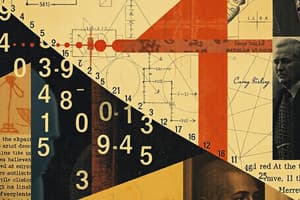Podcast
Questions and Answers
What type of pattern is demonstrated in the sequence: 1, 4, 9, 16, 25...?
What type of pattern is demonstrated in the sequence: 1, 4, 9, 16, 25...?
- Geometric
- Arithmetic
- Repeating
- Growing (correct)
Which of the following is NOT a type of symmetry?
Which of the following is NOT a type of symmetry?
- Rotational
- Translational
- Reflective (correct)
- Circular
A sequence where the difference between consecutive terms is constant is known as:
A sequence where the difference between consecutive terms is constant is known as:
- Geometric sequence
- Repeating sequence
- Arithmetic sequence (correct)
- Fibonacci sequence
In a geometric sequence, what is the relationship between consecutive terms?
In a geometric sequence, what is the relationship between consecutive terms?
What type of symmetry does a regular hexagon possess?
What type of symmetry does a regular hexagon possess?
In a repeating pattern, which of the following is TRUE?
In a repeating pattern, which of the following is TRUE?
The pattern 2, 4, 8, 16, 32... is an example of what kind of sequence?
The pattern 2, 4, 8, 16, 32... is an example of what kind of sequence?
In a sequence where each term is obtained by adding a constant value to the previous term, what is the constant value called?
In a sequence where each term is obtained by adding a constant value to the previous term, what is the constant value called?
What type of symmetry does a snowflake typically exhibit?
What type of symmetry does a snowflake typically exhibit?
If a pattern has rotational symmetry, it means that the pattern:
If a pattern has rotational symmetry, it means that the pattern:
Flashcards
Patterns in Mathematics
Patterns in Mathematics
Recurring sequences of numbers or shapes that follow a specific rule.
Arithmetic Sequence
Arithmetic Sequence
Consecutive terms have a constant difference.
Geometric Sequence
Geometric Sequence
Consecutive terms have a constant ratio.
Repeating Patterns
Repeating Patterns
Signup and view all the flashcards
Symmetry
Symmetry
Signup and view all the flashcards
Line Symmetry
Line Symmetry
Signup and view all the flashcards
Rotational Symmetry
Rotational Symmetry
Signup and view all the flashcards
Translational Symmetry
Translational Symmetry
Signup and view all the flashcards
Applications of Symmetry
Applications of Symmetry
Signup and view all the flashcards
Linking Patterns and Symmetry
Linking Patterns and Symmetry
Signup and view all the flashcards
Study Notes
Patterns in Mathematics
- Patterns are recurring sequences of numbers, shapes, or objects that follow a specific rule or formula.
- Recognizing patterns allows prediction of future elements in the sequence.
- Patterns can be arithmetic (addition/subtraction), geometric (multiplication/division), or a combination of both.
- Understanding patterns is fundamental in many branches of mathematics, including algebra, geometry, and calculus.
Types of Patterns
- Arithmetic sequences: Consecutive terms have a constant difference.
- Example: 2, 5, 8, 11... (difference of 3)
- Geometric sequences: Consecutive terms have a constant ratio.
- Example: 3, 6, 12, 24... (ratio of 2)
- Repeating patterns: Elements repeat in a fixed order.
- Example: A, B, C, A, B, C...
- Growing patterns: Elements increase or decrease according to a specific rule.
- Example: Square numbers (1, 4, 9, 16, ...)
Symmetry in Mathematics
- Symmetry refers to a balanced or proportionate arrangement of parts that creates a sense of harmony or regularity.
- It involves identical forms or shapes reflected across a line or rotated about a point.
Types of Symmetry
- Line symmetry: A shape can be folded along a line, so that both halves match exactly.
- The line of symmetry divides the shape into mirror-image halves.
- Example: An isosceles triangle, a rectangle.
- Rotational symmetry: A shape can be rotated about a central point by an angle to produce an identical shape.
- The angle of rotation is a fraction of 360 degrees.
- Example: A square, an equilateral triangle.
- Translational symmetry: Identical forms are repeated at regular intervals in a straight line.
- Example: Bricklaying, wallpaper patterns.
Applications of Symmetry
- Nature: Symmetry is frequently observed in natural objects, like snowflakes, flowers, and animals.
- Art and design: Artists frequently use symmetry to create aesthetically pleasing compositions.
- Architecture: Applying symmetry principles in architecture to create visually appealing and balanced structures.
- Science: Symmetry helps to understand laws of physics, like in crystals.
- Mathematics: Symmetry often leads to simplification in mathematical proofs and problems.
- Crystallography: Crystals exhibit translational and rotational symmetry.
Linking Patterns and Symmetry
- Patterns can exhibit symmetry.
- Recognizing symmetrical patterns can assist in simplifying patterns and calculations.
- Many mathematical formulas and equations demonstrate symmetry.
- Patterns assist in visualizing symmetry.
Examples of patterns and symmetry
- Example: The Fibonacci sequence (1, 1, 2, 3, 5, 8,...) shows patterns in nature.
- Example: A snowflake exhibits rotational and/or mirror symmetry.
- Example: The spirals formed by sunflower seeds demonstrate a specific mathematical pattern with inherent symmetry.
Connection Between Maths, Patterns, and Symmetry
- Patterns in mathematics guide and define symmetry. Recognizing them aids in identifying symmetry.
- Studying and understanding patterns is critical for identifying and appreciating symmetry elements.
- Mathematical proofs and equations often employ patterns and symmetry to make processes easier and more understandable.
Studying That Suits You
Use AI to generate personalized quizzes and flashcards to suit your learning preferences.




